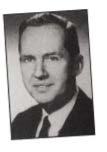With the fruits of his successful career in finance and banking, George Elder ’51 has a history of making wise investments. He is continuing that tradition by investing in the Whiting School, while receiving benefits in return.

George Elder ’51 likes to say his career was “checkered.” Certainly it was somewhat unorthodox, and undoubtedly it was successful. He was not one to squeeze into a mold just because somebody else thought he should.
Take, for instance, what his family had in mind. After he graduated from the Brunswick School in Connecticut, his family sent him to Williams College in Massachusetts, presumably to study science. With the Glee Club, he sang at all the area girls’ schools, but hit a sour note in academics. “I failed miserably,” he admits, and his family brought him home.
The next year, they tried another school for George (and please, call him George, he says). With his typical dry wit, George relates, “My family neglected to research the fact that Syracuse was coed.” He was very popular there, sang in the coed chorus, and loved to play the Hawaiian War Chant on the university’s chimes.

“I found that a technical background is valuable in anything that you do.”George Elder ’51
George did well enough academically at Syracuse, but his folks perhaps sensed he was having too much fun. Next they enrolled him in Columbia University’s summer chemistry lab, which he had to take before beginning classes there in the fall. However, his commute from Connecticut required train, trolley, and footwork. “On top of that, the class was hot, un-air-conditioned, and a drag,” he says, “so I enlisted.”
The military sent George to several schools as well. He ended up in the new Army Specialized Training Program (ASTP), geared to arming soldiers with a degree before deploying them. ASTP sent him to City College of New York to study civil engineering. When the Allies needed more infantry overseas, George, along with many others, was plucked from ASTP. Following basic training at Fort Carson, Colorado, he served in northern France, Belgium, Holland, and Germany as a rifleman with the 104th Infantry. Later, he taught in the Officer Candidate School at Fontainebleau until V-E Day.
Discharged in 1946, George joined his wife on Maryland’s Eastern Shore, where her father owned a farm. Each day before sunup and sundown, George milked the cows. He was finally able to complete a degree: At Washington College in Chestertown, he earned a bachelor’s in physics in 1948.
By this time, George had taken classes at no fewer than 10 institutions of higher learning. There was one more to come. He enrolled at the Johns Hopkins University in 1948 and three years later received his second bachelor’s degree, this one in Civil Engineering. Living off-campus with his wife, and supported mainly by the G.I. Bill, George had little time for campus activities, although he did assist in putting out the Vector, an Engineering newsletter.
After graduation, George took a job at the State Highway Commission, where he had worked during the summers. “I advanced there as far as I could, politically,” he recalls, “and then went to a water company in suburban Wilmington, Delaware.” What kind of work was this Hopkins engineer doing? Finance and investments. “It was somewhat unusual for a civil engineer to be involved in the financial side,” George admits. “But I found that a technical background is valuable in anything that you do.”
George came back to Baltimore, where he was with the Bank of America and its predecessors through 30 years of mergers and acquisitions. He retired as vice president in 1994, at age 74. Today, George lives near the Homewood campus with his wife, Hazel, a nurse and a descendant of Francis Scott Key.
While George grew up with a mind of his own, he eagerly learned from everyone around him. “I was interested in everything,” he relates, “and I enjoyed a range of constructive influences.” George’s stepfather (a physician) and his mother pursued antiques. As a teenager, George went along on many of their hunts and began to collect old and rare books, purchasing nothing published later than 1850. An uncle had started him on a rock and mineral collection around age 11, and after the war, he became interested in cutting and polishing the stones, as well as enlarging his collection.
A loyal friend to the Whiting School, George has been an annual donor for three decades. In 1993, he created a charitable gift annuity, which he has added to four times. He also has generously included the Whiting School, as well as Washington College, in his Will.
Asked about his philanthropy, George says, “It just makes sense. During my 30 years at the bank, I had lots of stock options and I took advantage of them. So I ended up with a good deal of stock worth far more than its original cost,” he explains. “By using this stock to create and increase the gift annuity, I avoided substantial capital gains tax. Also, the annuity provides me regular income at a favorable rate, and some of that income is tax-free. All this makes my giving sensible.”




